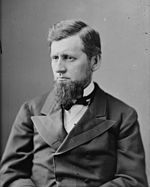United States Senate elections, 1900
|
|
|||||||||||||||||||||||||||||||||||||||||||||||||||||||||||||||||||
|---|---|---|---|---|---|---|---|---|---|---|---|---|---|---|---|---|---|---|---|---|---|---|---|---|---|---|---|---|---|---|---|---|---|---|---|---|---|---|---|---|---|---|---|---|---|---|---|---|---|---|---|---|---|---|---|---|---|---|---|---|---|---|---|---|---|---|---|
|
|||||||||||||||||||||||||||||||||||||||||||||||||||||||||||||||||||
|
30 of the 90 seats in the U.S. Senate (as well as special elections) 46 seats needed for a majority |
|||||||||||||||||||||||||||||||||||||||||||||||||||||||||||||||||||
|
|||||||||||||||||||||||||||||||||||||||||||||||||||||||||||||||||||
|
|||||||||||||||||||||||||||||||||||||||||||||||||||||||||||||||||||
Republican
Republican
The United States Senate elections of 1900 and 1901 were elections in which the Democratic Party gained two seats in the United States Senate, and which corresponded with President William McKinley's landslide re-election. By the beginning of the next Congress, however, the Republicans gained five additional seats, giving them a ten-seat majority.
As these elections were prior to ratification of the seventeenth amendment, Senators were chosen by state legislatures.
Senate Party Division, 57th Congress (1901–1903)
At the beginning of 1900.
In these elections, the winner was seated in the current (56th) Congress during 1900 or in 1901 before March 4; ordered by election date.
In this election, the winner was seated in the 58th Congress, starting March 4, 1903.
In these general elections, the winners were elected for the term beginning March 4, 1901; ordered by state.
All of the elections involved the Class 2 seats.
In this election, the winner was elected in 1901 after March 4 and seated in the 57th Congress.
The special election in Pennsylvania was held on January 15, 1901, after the regularly scheduled legislative election in January–April 1899 failed to elect a Senator. Former Senator Matthew Quay, who had left the Senate for nearly two years because of the political stalemate, was again elected by the Pennsylvania General Assembly to the United States Senate.
Republican Matthew Quay was re-elected by the Pennsylvania General Assembly, consisting of the House of Representatives and the Senate, in the 1893 election. With Sen. Quay's term expiring on March 4, 1899, the General Assembly convened on January 18, 1899, to elect a Senator for the next term. Between January 18 and April 19, 1899, seventy-nine ballots were recorded in an attempt to elect a Senator. Instead, the legislature adjourned sine die without electing a Senator due to a dispute between Sen. Quay's political machine and an anti-Quay faction within the Republican Party, along with Democratic Party opposition.
...
Wikipedia


